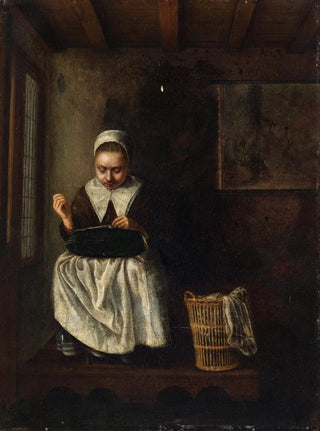Art print | A girl sewing - Nicolaes Maes Source: Reproduction | Une fille qui coud - Nicolaes Maes


View from behind

Frame (optional)
The art print "Une fille qui coud" by Nicolaes Maes, painted in the 17th century, brilliantly embodies the very essence of Dutch bourgeois daily life. This painting, both intimate and evocative, immerses us in the domestic universe of a time when family life and craft activities played a prominent role. The scene depicts a young girl absorbed in her sewing work, an activity that, beyond its apparent simplicity, reveals deep social and cultural issues. Through this subject choice, Maes invites us to contemplate the beauty of everyday gestures, while highlighting the delicacy and patience required to complete a sewing project. This work, through its realism and finesse, transports us to a suspended moment, where time seems to stand still to celebrate the meticulousness of artisanal craftsmanship.
Style and uniqueness of the work
Nicolaes Maes's style is characterized by striking realism and particular attention to detail. In "Une fille qui coud," light plays a crucial role, illuminating the young girl's face and creating soft shadows that add an almost tangible dimension to the scene. The textures of fabrics and materials are rendered with remarkable precision, demonstrating Maes's talent for capturing matter. The artist uses a delicate color palette, blending warm tones and natural shades, which gives the art print a warm and welcoming atmosphere. The composition is carefully balanced, with a simple background that highlights the central figure. This approach, both realistic and poetic, allows the viewer to feel an emotional connection with the young seamstress, while celebrating the beauty of simple gestures.
The artist and his influence
Nicolaes Maes, a pupil of Rembrandt, is often regarded as one of the masters of portrait and genre painting in the 17th century. His career, marked by stylistic evolution, reflects the profound influence of his mentor while developing a unique artistic voice. Maes stands out for his ability to capture everyday life with a unique sensitivity, paying homage to ordinary characters while endowing them with a

Matte finish

View from behind

Frame (optional)
The art print "Une fille qui coud" by Nicolaes Maes, painted in the 17th century, brilliantly embodies the very essence of Dutch bourgeois daily life. This painting, both intimate and evocative, immerses us in the domestic universe of a time when family life and craft activities played a prominent role. The scene depicts a young girl absorbed in her sewing work, an activity that, beyond its apparent simplicity, reveals deep social and cultural issues. Through this subject choice, Maes invites us to contemplate the beauty of everyday gestures, while highlighting the delicacy and patience required to complete a sewing project. This work, through its realism and finesse, transports us to a suspended moment, where time seems to stand still to celebrate the meticulousness of artisanal craftsmanship.
Style and uniqueness of the work
Nicolaes Maes's style is characterized by striking realism and particular attention to detail. In "Une fille qui coud," light plays a crucial role, illuminating the young girl's face and creating soft shadows that add an almost tangible dimension to the scene. The textures of fabrics and materials are rendered with remarkable precision, demonstrating Maes's talent for capturing matter. The artist uses a delicate color palette, blending warm tones and natural shades, which gives the art print a warm and welcoming atmosphere. The composition is carefully balanced, with a simple background that highlights the central figure. This approach, both realistic and poetic, allows the viewer to feel an emotional connection with the young seamstress, while celebrating the beauty of simple gestures.
The artist and his influence
Nicolaes Maes, a pupil of Rembrandt, is often regarded as one of the masters of portrait and genre painting in the 17th century. His career, marked by stylistic evolution, reflects the profound influence of his mentor while developing a unique artistic voice. Maes stands out for his ability to capture everyday life with a unique sensitivity, paying homage to ordinary characters while endowing them with a






